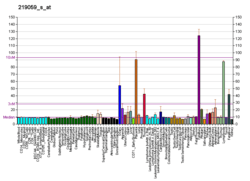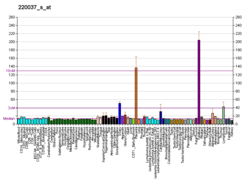LYVE1
Lymphatic vessel endothelial hyaluronan receptor 1 (LYVE1), also known as extracellular link domain containing 1 (XLKD1) is a Link domain-containing hyaladherin, a protein capable of binding to hyaluronic acid (HA), homologous to CD44, the main HA receptor.[5] In humans it is encoded by the LYVE1 gene.[6]
LYVE1 is a type I integral membrane glycoprotein. It acts as a receptor and binds to both soluble and immobilized hyaluronan. This protein may function in lymphatic hyaluronan transport and have a role in tumor metastasis.[6] LYVE-1 is a cell surface receptor on lymphatic endothelial cells that can be used as a lymphatic endothelial cell marker, allowing for the isolation of these cells for experimental purposes. The physiological role for this receptor is still the subject of debate, but evolutionary conservation suggests an important role.
References
- 1 2 3 GRCh38: Ensembl release 89: ENSG00000133800 - Ensembl, May 2017
- 1 2 3 GRCm38: Ensembl release 89: ENSMUSG00000030787 - Ensembl, May 2017
- ↑ "Human PubMed Reference:".
- ↑ "Mouse PubMed Reference:".
- ↑ Banerji, Suneale; Ni, Jian; Wang, Shu-Xia; Clasper, Steven; Su, Jeffrey; Tammi, Raija; Jones, Margaret; Jackson, David G. (22 February 1999). "LYVE-1, a New Homologue of the CD44 Glycoprotein, Is a Lymph-specific Receptor for Hyaluronan". The Journal of Cell Biology. 144 (4): 789–801. doi:10.1083/jcb.144.4.789. PMC 2132933. PMID 10037799.
- 1 2 "LYVE1 lymphatic vessel endothelial hyaluronan receptor 1 [ Homo sapiens (human) ]".
Further reading
- Jackson DG (2003). "The lymphatics revisited: new perspectives from the hyaluronan receptor LYVE-1". Trends Cardiovasc. Med. 13 (1): 1–7. doi:10.1016/S1050-1738(02)00189-5. PMID 12554094.
- Banerji S, Ni J, Wang SX, et al. (1999). "LYVE-1, a new homologue of the CD44 glycoprotein, is a lymph-specific receptor for hyaluronan". J. Cell Biol. 144 (4): 789–801. doi:10.1083/jcb.144.4.789. PMC 2132933. PMID 10037799.
- Cunnick GH, Jiang WG, Gomez KF, Mansel RE (2001). "Lymphangiogenesis quantification using quantitative PCR and breast cancer as a model". Biochem. Biophys. Res. Commun. 288 (4): 1043–6. doi:10.1006/bbrc.2001.5869. PMID 11689016.
- Mouta Carreira C, Nasser SM, di Tomaso E, et al. (2001). "LYVE-1 is not restricted to the lymph vessels: expression in normal liver blood sinusoids and down-regulation in human liver cancer and cirrhosis". Cancer Res. 61 (22): 8079–84. PMID 11719431.
- Cursiefen C, Schlötzer-Schrehardt U, Küchle M, et al. (2002). "Lymphatic vessels in vascularized human corneas: immunohistochemical investigation using LYVE-1 and podoplanin". Invest. Ophthalmol. Vis. Sci. 43 (7): 2127–35. PMID 12091407.
- Strausberg RL, Feingold EA, Grouse LH, et al. (2003). "Generation and initial analysis of more than 15,000 full-length human and mouse cDNA sequences". Proc. Natl. Acad. Sci. U.S.A. 99 (26): 16899–903. doi:10.1073/pnas.242603899. PMC 139241. PMID 12477932.
- Huang SS, Tang FM, Huang YH, et al. (2003). "Cloning, expression, characterization, and role in autocrine cell growth of cell surface retention sequence binding protein-1". J. Biol. Chem. 278 (44): 43855–69. doi:10.1074/jbc.M306411200. PMID 12912978.
- Clark HF, Gurney AL, Abaya E, et al. (2003). "The secreted protein discovery initiative (SPDI), a large-scale effort to identify novel human secreted and transmembrane proteins: a bioinformatics assessment". Genome Res. 13 (10): 2265–70. doi:10.1101/gr.1293003. PMC 403697. PMID 12975309.
- Gerhard DS, Wagner L, Feingold EA, et al. (2004). "The status, quality, and expansion of the NIH full-length cDNA project: the Mammalian Gene Collection (MGC)". Genome Res. 14 (10B): 2121–7. doi:10.1101/gr.2596504. PMC 528928. PMID 15489334.
- Otsuki T, Ota T, Nishikawa T, et al. (2007). "Signal sequence and keyword trap in silico for selection of full-length human cDNAs encoding secretion or membrane proteins from oligo-capped cDNA libraries". DNA Res. 12 (2): 117–26. doi:10.1093/dnares/12.2.117. PMID 16303743.
- Liu T, Qian WJ, Gritsenko MA, et al. (2006). "Human plasma N-glycoproteome analysis by immunoaffinity subtraction, hydrazide chemistry, and mass spectrometry". J. Proteome Res. 4 (6): 2070–80. doi:10.1021/pr0502065. PMC 1850943. PMID 16335952.
- Kimura K, Wakamatsu A, Suzuki Y, et al. (2006). "Diversification of transcriptional modulation: large-scale identification and characterization of putative alternative promoters of human genes". Genome Res. 16 (1): 55–65. doi:10.1101/gr.4039406. PMC 1356129. PMID 16344560.
- Nguyen VA, Kutzner H, Fürhapter C, et al. (2006). "Infantile hemangioma is a proliferation of LYVE-1-negative blood endothelial cells without lymphatic competence". Mod. Pathol. 19 (2): 291–8. doi:10.1038/modpathol.3800537. PMID 16424896.
- Gu B, Alexander JS, Gu Y, et al. (2007). "Expression of lymphatic vascular endothelial hyaluronan receptor-1 (LYVE-1) in the human placenta". Lymphatic research and biology. 4 (1): 11–7. doi:10.1089/lrb.2006.4.11. PMC 3072054. PMID 16569201.
- Llovet JM, Chen Y, Wurmbach E, et al. (2007). "A molecular signature to discriminate dysplastic nodules from early hepatocellular carcinoma in HCV cirrhosis". Gastroenterology. 131 (6): 1758–67. doi:10.1053/j.gastro.2006.09.014. PMID 17087938.





